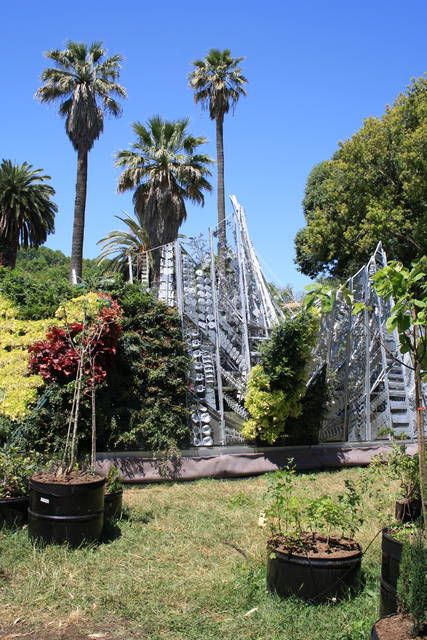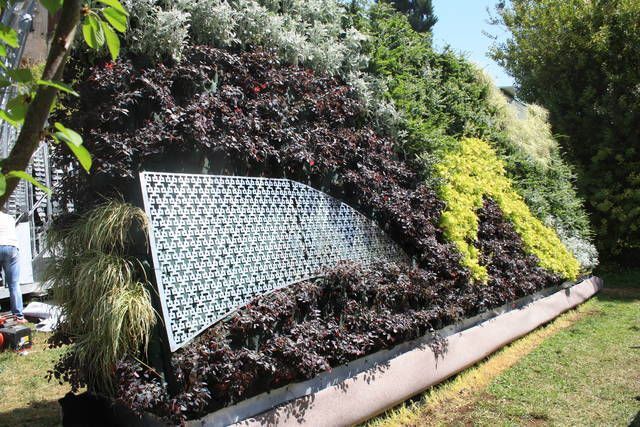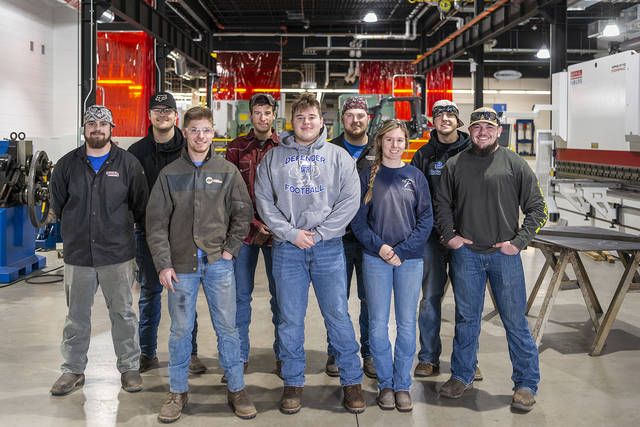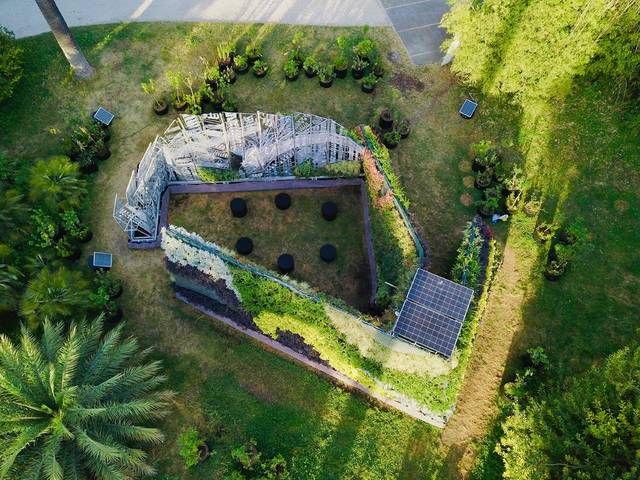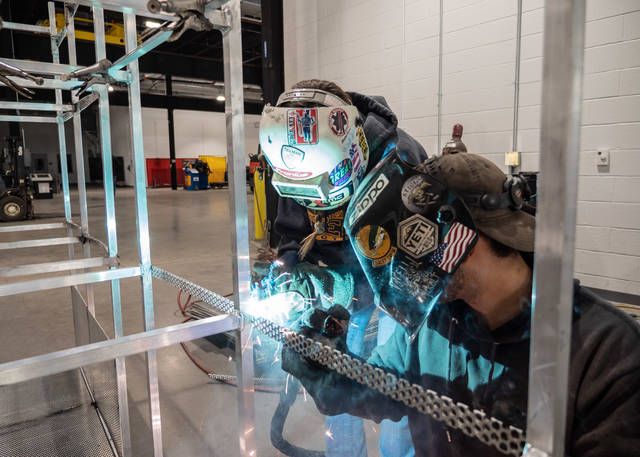
Assistant professor of welding Jim Colton, from Pennsylvania College of Technology in Williamsport, works on a wall that has become part of a Living Chapel. With recycled metal and living plants in its walls, the environmentally friendly chapel is currently in Rome, and will eventually be taken to Assisi, Italy.
Pennsylvania College of Technology
‘They were incredibly creative,’ architect says
Click here to subscribe today or Login.
High on Jim Colton’s list of places to visit is Italy — either Rome, where a new Living Chapel will be displayed for a while, or Assisi, which will become the permanent home of the structure that Colton and his welding students helped build at Pennsylvania College of Technology in Williamsport.
“It was definitely a once-in-a-lifetime project,” Colton said earlier this week, explaining he was impressed by plans for the environmentally friendly structure, which boasts recycled and re-purposed materials as well as a solar-powered irrigation system that supports thousands of leaves and flowers now living in its walls.
“We built a small part of it,” he said modestly, adding that, now that the Living Chapel is completely assembled, he’s eager to “see it up close and go, ‘Hey, we helped build that.’ “
So is Chad Phillips, 22, of Dallas, a Penn College welding and fabrication engineering technology major who helped fabricate the aluminum walls.
“It was awesome to work with the teachers and other students,” said Phillips, who “fell in love with working with my hands” a few years earlier, as a student at Wilkes-Barre Area Career & Technical Center.
“It was such a huge project,” Phillips said.
Indeed, as a news release from the school explains, the Penn College crew of 15 students and nine faculty members worked more than 3,500 hours over 10 weeks from November through January. They used nearly 5,000 feet of aluminum, which equals about 16 football fields in length, to build the walls for the chapel, which is “designed to integrate nature, art, music and architecture.”
The Living Chapel was unveiled earlier this month in Italy during Global Catholic Climate Movement activities and will be formally unveiled via live streaming on June 5 in honor of United Nations World Environment Day. It will remain at the Botanical Garden of Rome until coronavirus restrictions are sufficiently relaxed for it to be moved to the Vatican. After that, it will be taken to Assisi, birthplace of St. Francis, who is the patron saint of ecology.
The project involved a great deal of international collaboration, including the efforts of its creative director, Julian Revie, who is an associate director of music at the Center for Music and Liturgy of Saint Thomas More Chapel at Yale University, and Gillean Denny, an independent architectural designer from Toronto, Canada.
“It was definitely challenging because the structure was still evolving as we were fabricating it,” Colton said. “We would get the plans for Wall A and while we were working on that wall, Gillean would finalize the plans for what Wall B would look like, and so on.”
“It had to be on a boat (to Italy) by the beginning of February,” Colton said, recalling how his team was still welding while the structure was being loaded on a truck in January, to be taken to Penn State University’s Main Campus, where other parts of the project — including musical chimes and the irrigation system — would come together.
Denny, the architectural designer, had been a student at Penn State University’s Stuckeman School years earlier, and brought one of her Penn State mentors, James Kalsbeek, into the collaboration. He in turn invited the team from Penn College.
“Once Kalsbeek realized Penn State didn’t possess the resources to construct such a large structure, he contacted Penn College, which enjoys a long history with the Penn State architecture program,” Penn College spokesman Thomas Speicher wrote. “Each year, Stuckeman School students — including Denny in 2002 — receive hands-on building experience by visiting the college’s masonry lab to cut stone and lay brick.”
“Kalsbeek’s request in September to extend the relationship to the welding and metal fabrication department was well-timed. Penn College recently opened its expanded 55,000-square-foot welding lab, believed to be the nation’s largest,” continued Speicher, who is a writer and video producer in the office of Public Relations and Marketing at Pennsylvania College of Technology. “The facility provided ample space and fabrication equipment, such as electric cold saws, portable band saws, grinders and MIG (metal inert gas) welding units.”
“The faculty saw this as a huge opportunity for students and the institution,” said Bradley M. Webb, dean of industrial, computing and engineering technologies. “It would help students with their practical skills, and given the significance of the project, carry the Penn College name for generations. They would not let this fail.”
“It was great to see our teachers so involved and so committed to something, because their dedication made me more dedicated to the project,” said Sara Stafford, a welding and fabrication engineering student from West Chester. “They did an amazing job, and it was flattering and humbling to say that I worked with them on that.”
Phillips, from Dallas, concurred, explaining he enjoyed working side-by-side with instructors.
Denny, the architect, said the project would not have come to fruition without the Penn College team.
“Not only were they instrumental in actually fabricating it, but they helped us work through the design of it, to make changes, to make it easier and better to build, and stronger,” she said. “They were incredibly creative.”
For the foreseeable future, the Living Chapel, which includes close to 5,000, 1-inch welds courtesy of the Penn College team, will remain at the Botanical Garden of Rome, where it is surrounded by recycled oil barrels that contain 2,500 saplings representing 46 tree species from Central and Southern Europe. The eventual plan calls for a permanent home near the grounds of the Basilica of St. Mary of the Angels, which is a UNESCO world Heritage site and home to St. Francis’ chapel.





